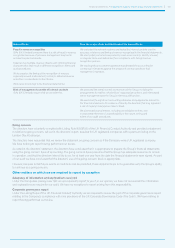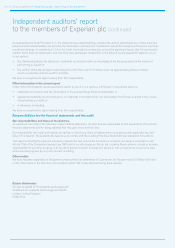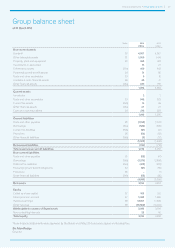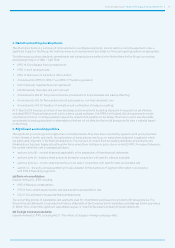Experian 2014 Annual Report Download - page 105
Download and view the complete annual report
Please find page 105 of the 2014 Experian annual report below. You can navigate through the pages in the report by either clicking on the pages listed below, or by using the keyword search tool below to find specific information within the annual report.
101
Financial statements • Independent auditors’ report: Group financial statements
Overview of our audit approach
Materiality
We set certain thresholds for materiality. These helped us to determine the nature, timing and extent of our audit procedures
and to evaluate the effect of misstatements, both individually and on the financial statements as a whole.
Using our professional judgement, we determined materiality for the Group financial statements as a whole to be US$52m, which
represents 5% of profit before tax.
We agreed with the Audit Committee that we would report to them misstatements identified during our audit above US$5m as well
as misstatements below that amount that, in our view, warranted reporting for qualitative reasons.
Overview of the scope of our audit
The Group is structured into five geographical regions, being North America, Latin America, UK and Ireland, Europe, Middle East
and Africa (‘EMEA’) and Asia Pacific (‘APAC’). Each region comprises a number of reporting units. The Group financial statements
comprise the financial information of these reporting units and the Group’s central functions.
In establishing the overall approach to the Group audit, we determined the type of work that needed to be performed at the reporting
units by us, as the Group engagement team, or component auditors within PwC UK and from other PwC network firms operating
under our instruction. Where the work was performed by component auditors, we determined the level of involvement we needed
to have in the audit work at those reporting units to be able to conclude whether sufficient appropriate audit evidence had been
obtained as a basis for our opinion on the Group financial statements as a whole.
Across these regions, we identified three reporting units (North America, Serasa SA and the United Kingdom) that required an audit
of their complete financial information due to size alone. These three reporting units comprise 95% of the Group’s profit before tax
and 83% of the Group’s revenue. Our audit work at these reporting units, together with procedures at the consolidated Group level,
gave us the evidence we needed for our opinion on the consolidated financial statements taken as a whole.
Areas of particular audit focus
In preparing the financial statements, the directors made a number of subjective judgements, for example in respect of significant
accounting estimates that involved making assumptions and considering future events that are inherently uncertain. We primarily
focused our work in these areas by assessing the directors’ judgements against available evidence, forming our own judgements,
and evaluating the disclosures in the financial statements.
In our audit, we tested and examined information, using sampling and other auditing techniques, to the extent we considered
necessary to provide a reasonable basis for us to draw conclusions. We obtained audit evidence through testing the effectiveness
of controls, substantive procedures or a combination of both.
We considered the following areas to be those that required particular focus in the current year. This is not a complete list of all risks
or areas of focus identified by our audit. We discussed these areas of focus with the Audit Committee. Their report on those matters
that they considered to be significant issues in relation to the financial statements is set out in the corporate governance report.
























